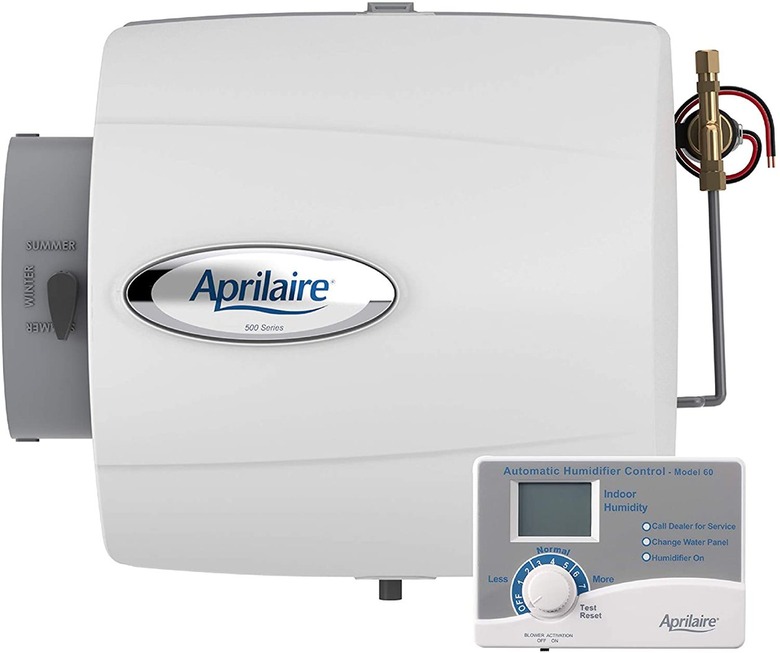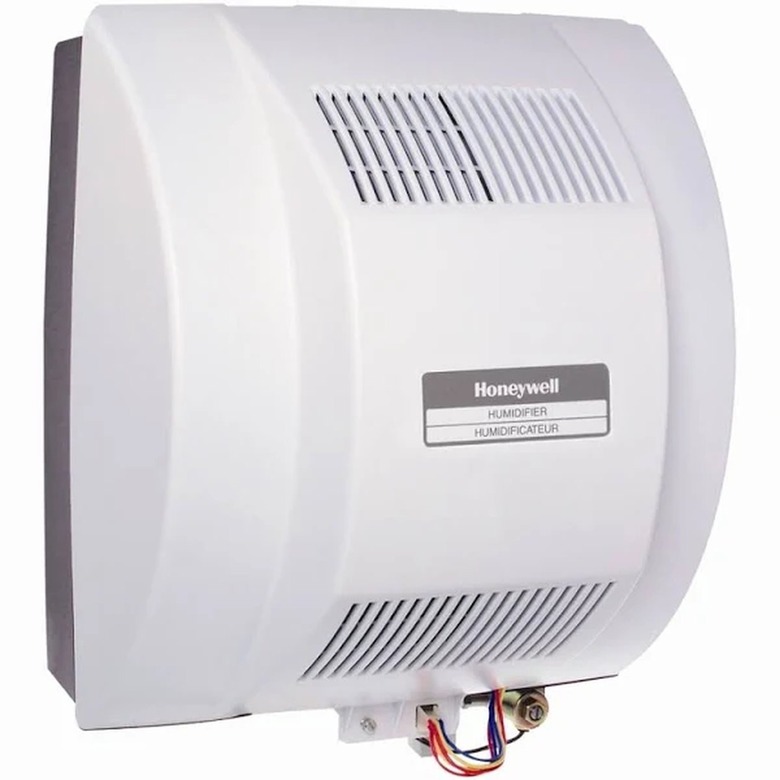How To Clean And Maintain A Whole-House Humidifier
We may receive a commission on purchases made from links.
Working in tandem with your HVAC system, your whole-house humidifier helps keep you comfortable regardless of the temperature and climate outside. Especially during winter's heating season, when dry air can cause humidity levels to plummet, a whole-house humidifier puts the right amount of moisture in the air without adversely impacting indoor air quality. The caveat is that in order to optimize your humidifier's performance, homeowners must clean and maintain it regularly. Luckily, it's an easy enough job suitable for a DIY home improvement project.
Although each whole-house humidifier model has its own set of cleaning and maintenance instructions, there are some general rule-of-thumb guidelines to help with your humidifier maintenance and cleaning routine. Always consult the owner's manual for model-specific instructions and be sure to contact the manufacturer's customer service support team if you hit a snag or have any questions.
Importance of Keeping Humidifiers Maintained
Importance of Keeping Humidifiers Maintained
If you forget to clean or maintain your whole-house humidifier according to manufacturer recommendations, it may not be able to meet your expectations by doing the job that likely prompted you to purchase it in the first place. In fact, it may even do more harm than good. When something is off-kilter with your whole-house humidifier, it may not keep the indoor humidity within the optimal range of 30 and 50 percent. If the level falls below 30 percent, your comfort also decreases. If the level is above 50 percent, you run the risk of creating a damp environment that encourages the growth of mold.
Because a whole-house humidifier works with your home's central air conditioning and heating system, keeping your heater and air conditioner components in tip-top shape also improves the performance of your humidifier. Replace air conditioner and heating unit air filters according to manufacturer specifications (if you have a disposable type) or cleaned (if you have a permanent filter) and follow all instructions in your owner's manual for routine maintenance on your HVAC system. Consider having your air ducts cleaned if there is mold growth inside.
Even if you're cleaning and maintaining your whole-house humidifier by the book, an easy way to make sure that your indoor humidity falls in that sweet spot of 30 to 50 percent is to use a humidity gauge. By using this simple gadget, you can periodically check the humidity level to make sure that your humidifier is working as expected. You can purchase an inexpensive battery-operated humidity gauge for less than $20. Some whole-house humidifiers, however, include a humidistat to perform this function.
Whole-House Humidifier Variables
Whole-House Humidifier Variables
A cleaning and maintenance checklist for your whole-house humidifier follows a general protocol for all humidifiers, but it's fine-tuned according to the specific model you have. There are two primary categories of humidifiers, with different types of humidifiers in each category. Identify the category of humidifier you have and then follow the cleaning and maintenance steps for your specific type.
Whole-house humidifier categories:
- Bypass humidifiers connect to your HVAC system's
return duct and utilize its blower to move moisture through your home,
either by the air handler or furnace, and they work when the HVAC system is
actively running. - Fan-powered humidifiers use their own fans to move
moisture through your home's ductwork, which means that this type increases
humidity even when the HVAC system isn't actively running.
Whole-house humidifier types:
- Drum humidifiers
- Flow-through (also called evaporative) humidifiers
- Steam humidifiers
For example, a drum humidifier may be either a bypass humidifier or a fan-powered humidifier. Both types have evaporator pads, which produce humidity, and both types of pads need to be replaced as part of routine maintenance, but the type of pad and frequency of replacement may vary between these models.
General Cleaning and Maintenance Checklist
General Cleaning and Maintenance Checklist
Before cleaning or performing any maintenance on your whole-house humidifier, always be sure to disconnect the power to it. Don't just turn it off; be sure to unplug it. Even if it's not time for a routine cleaning, any time you detect a foul odor coming from your humidifier, it's time to clean it.
- Remove the water reservoir and clean it. Be sure
to observe the instructions for safely and properly removing the water supply reservoir,
which you'll find in the owner's manual. Discard any water left in the
reservoir before cleaning it with soap and water. Rinse thoroughly and let it
air dry. Add distilled water to the fill line and add a few drops of chlorine bleach if your owner's manual advocates using bleach in your humidifier. Avoid using tap
water because it contains mineral deposits that may build up in your
humidifier as lime scale. Also consult your owner's manual for the frequency
needed for changing the water. Some models may require daily changing during periods of high humidifier use, while others need fresh water added every few weeks. - Clean the water panel. When you clean the water
reservoir, also clean the water panel, which consists of a filter, a water pad
and an evaporator pad. Soak the panel in cold water to loosen any debris before
gently wiping it down to remove the debris. If your humidifier's pads are made
of foam, they're probably held in place with clips. Unclip the pads, wring the
water out of them and clean them with vinegar and water. Wring them out again
before clipping them back in place. If you notice that the pads have hardened,
go ahead and replace them. The entire panel generally needs replacing once a
year. - Check for leaks. Each time you clean your whole-house humidifier, check it for possible leaks. Look on the floor around your
unit to make sure there's no standing water. - Check the humidistat. If your whole-house humidifier has a humidistat, make sure it's on and working properly.
Model-Specific Cleaning and Maintenance Tips
Model-Specific Cleaning and Maintenance Tips
Although drum-type whole-house humidifiers are generally the most affordable models, they may require more cleaning and maintenance. To stay on top of potential mold growth, which is more common in drum humidifiers than other types, be sure to keep the water reservoir and water panel cleaned with the frequency suggested in your owner's manual.
Flow-through (evaporative) humidifiers have a tendency to use more water than other models, so you may need to check the water level with the frequency suggested in your owner's manual. During higher-use periods — like winter when the heating system tends to keep the air inside your home drier than during summer — you may want to check the water level often.
Even though steam-type humidifiers are typically the most efficient types, with a lower risk of mold growth, you may still need to tend to your specific model more often during winter and other peak-use periods. Humidifier use is also climate-dependent. For example, if you live in an arid climate, your steam humidifier will likely work harder in summer than if you live in the humid South.
The owner's manual for your whole-house humidifier model may also recommend draining your humidifier and storing it before you leave for vacation or an extended business trip. This simple step can help prolong the life of your humidifier and mitigate the risk from any mold buildup while you're away.
References
- United States Environmental Protection Agency: Care for Your Air – A Guide to Indoor Air Quality
- Aprilaire: Cleaning & Maintaining Your Aprilaire Humidifier
- Dependable Heating & Air Conditioning: A Quick Guide to Cleaning Whole-House Humidifiers
- Powers Heating & Cooling: A Guide to Maintaining and Replacing Your Drum-Style Humidifier
- HomeAdvisor: How Much Does it Cost to Install a Humidifier?

